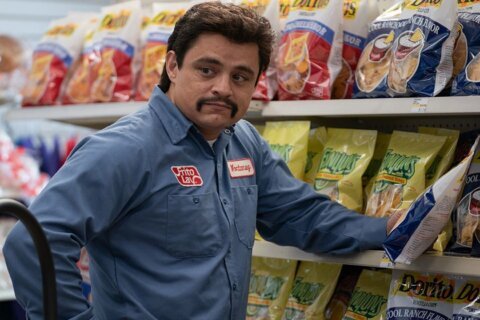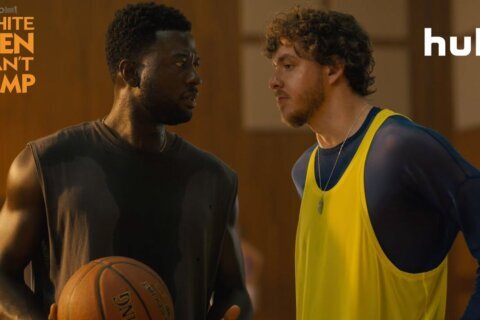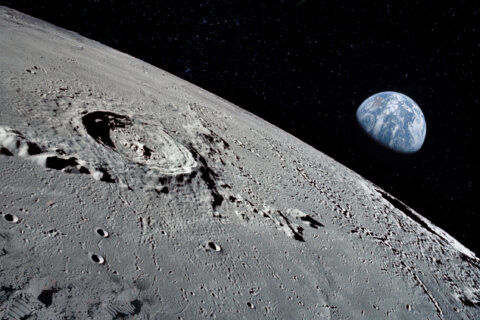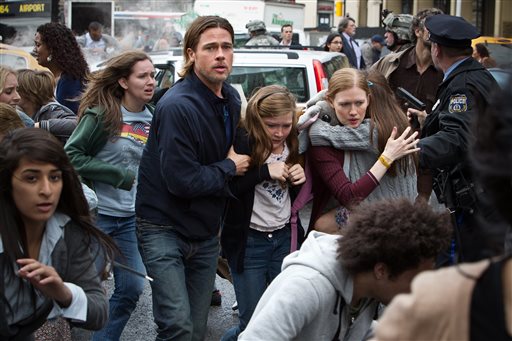
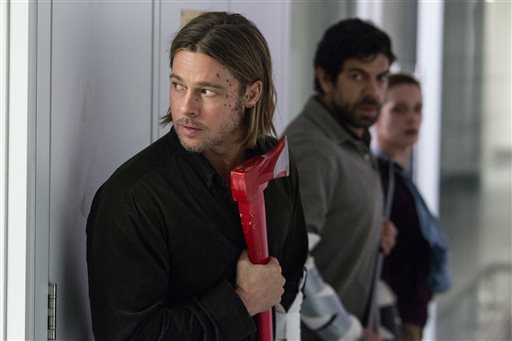
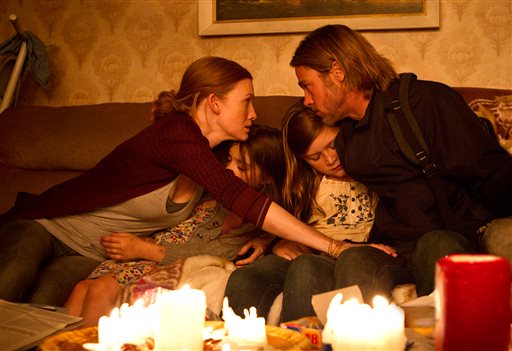
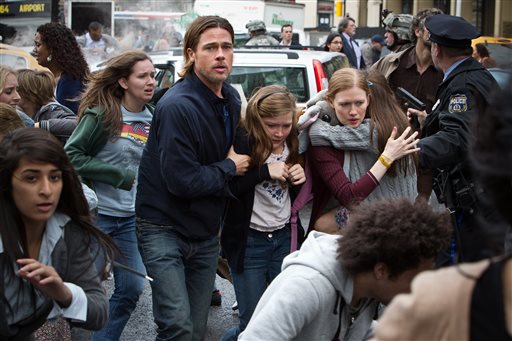
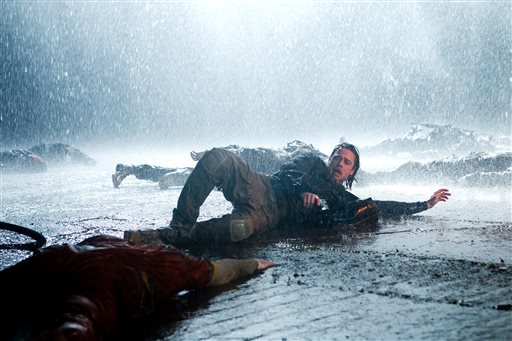
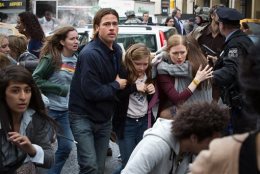

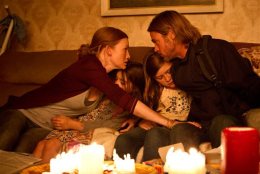
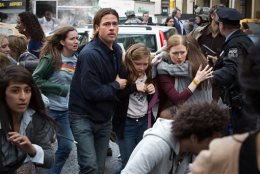
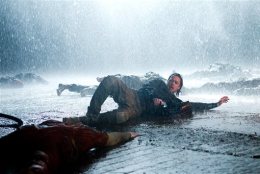
WASHINGTON – From “28 Days Later” (2002) to “Shaun of the Dead” (2004), “Zombieland” (2009) to “The Walking Dead” (2010), we’re officially living in the zombie millennium.
This recent explosion is largely due to an unlikely conduit — the son of Mel Brooks and Anne Bancroft. Author Max Brooks has penned two best-selling zombie page-turners: “The Zombie Survival Guide” (2003), a survival manual in the event of an actual zombie attack, and “World War Z: An Oral History of the Zombie War” (2006), apocalyptic fiction in episodic first-hand accounts.
Brad Pitt so loved the latter that his Plan B production company bought the rights. But if you’ve been following the Hollywood trades, it seemed like a disaster waiting to happen. Pitt and company had to re-shoot the final 40 minutes after the climax tanked in test screenings, pushing the budget to $200 million and delaying the release from Dec. 21, 2012 to June 21, 2013.
While this ruined plans to coincide with the end of the Mayan Calendar, Pitt’s gamble has surprisingly paid off. What seemed “dead on arrival,” is now “Dawn of the Dead,” a delayed release we can now affectionately call “180 Days Later.”
The plot follows United Nations retiree Gerry Lane (Brad Pitt), who’s now a stay-at-home dad in Philly. One day, while driving downtown with his wife (Mireille Enos, TV’s “The Killing”) and kids (Abigail Hargrove and Sterling Jerins), a traffic jam quickly turns into a zombie attack, giving new meaning to Springsteen’s “Streets of Philadelphia” lyrics: “At night I hear the blood in my veins.” It’s chow time.
Luckily, Gerry has U.N. connections and can fly his family to a remote aircraft carrier in the Atlantic. There’s just one catch: the military will protect his family only if he embarks on a globe-trotting mission from South Korea to Israel to Wales to find a cure to the global zombie pandemic.
After a career playing hunky young drifters (“Thelma & Louise”), short-tempered detectives (“Se7en”) and brash cult founders (“Fight Club”), Pitt has settled nicely into fatherly roles like “Babel” (2006), “Moneyball” (2011) and “The Tree of Life” (2011). He also makes a fine action hero, looking like Fabio the Zombie Killer with long, flowing locks and magazines taped to his arms to prevent zombie bites.
The decision to follow Lane’s hero journey in traditional narrative structure will prove controversial, as the script ditches the book’s fractured approach of episodic vignettes.
“I cannot guarantee that the movie will be the book that they love,” Brooks told The Huffington Post, hedging his bets. “I’m in no position to tell people to see this movie or not see it. If I’m asked I say: See the movie as a movie and judge it as a movie.”
Written by Matthew Michael Carnahan (“Lions for Lambs,” “State of Play”), J. Michael Straczynski (“Babylon 5,” “Changeling”) and a pair of “Lost” alums Drew Goddard (“Cloverfield,” “Cabin in the Woods”) and Damon Lindelof (“Prometheus,” “Star Trek: Into Darkness”), the script blends clever dialogue with social commentary, comparing Mother Nature to a serial killer.
The story, however, lacks much of a set-up, diving straight into the zombie catalyst early on. As the second act progresses, the backstory of Gerry’s U.N. past and the specific cause of the zombie outbreak remain rather murky. As Pitt’s character says, “Movement is life,” and there’s no time to look back — a complete departure from the constant flashbacks in “Man of Steel” (2013).
It would have been interesting to see the film presented in vignettes, each directed by a different filmmaker. Instead, the reins are given to the very capable Marc Forster, who burst onto the scene with a Slamdance Audience Award for “Loungers” (1995) and a Sundance Grand Jury Prize nomination for “Everything Put Together” (2000). He then directed Halle Berry to an Oscar in “Monster’s Ball” (2001), earned a Best Director Golden Globe nomination for “Finding Neverland” (2004), helmed the impressive “Stranger Than Fiction” (2006) and earned a BAFTA nomination for “The Kite Runner” (2007) before directing the lackluster Bond flick “Quantum of Solace” (2008).
Forster has bounced back with a vengeance in “World War Z,” working within PG-13 parameters that actually benefit his vision by allowing him to leave much of the gore off-screen. Less is always more.
His tone moves from the action/horror of James Cameron’s “Aliens” (1986) to the suspense/horror of Ridley Scott’s “Alien” (1979), a transition that would not have worked the other way around.
The first two acts are filled with thrilling action set-pieces. The opening downtown attack features zombie flying headbutts into Pitt’s windshield that recall the dive-bombing cracked glass of the telephone booth in Hitchcock’s “The Birds” (1963). The action builds to a nail-biting sequence of airplane chaos, mining tension from the “torn curtain” between first class and coach. Pay no attention to the zombie behind the curtain. Just call Samuel L. Jackson. We have “zombies on a plane.”
While this could have easily given way to a flash-bang finale, the re-shoot allows Forster to end with a riveting finale inside a medical lab, as Pitt must tiptoe his way past a group of dormant zombies, who are ready to be awakened by even the faintest sound of a foot stepping on broken glass. All the while, Pitt’s human colleagues are forced to watch — like we the audience — from hallway surveillance cameras, wanting to yell out instructions, but knowing Pitt can’t hear us, just like Grace Kelly in “Rear Window.” It’s all surprisingly self-reflexive for a genre that’s been done to death.
As for the zombies themselves, the film presents them as a mix between the straight suspense of George Romero (“Night of the Living Dead”) and the horror/comedy of Sam Raimi (“The Evil Dead”). The comedy should be no surprise, coming from Mel Brooks’ son, who won a Primetime Emmy with Tina Fey’s “SNL” writing team in 2002. And so, the zombies in “World War Z” are both relentless in CGI ant-hill swarms, and deliciously funny with twitching actors in good old- fashioned makeup. Even masters of suspense like Hitchcock knew that thrillers are only a few steps removed from black comedy. We must laugh in the face of terror. Thankfully, Forster gets it.
★ ★ ★
The above rating is based on a 4-star scale. Follow WTOP Film Critic Jason Fraley on Twitter @AboveTheJFray, read his blog at The Film Spectrum or listen every Friday morning on WTOP Radio 103.5 FM.
Follow @WTOP and @WTOPliving on Twitter.


